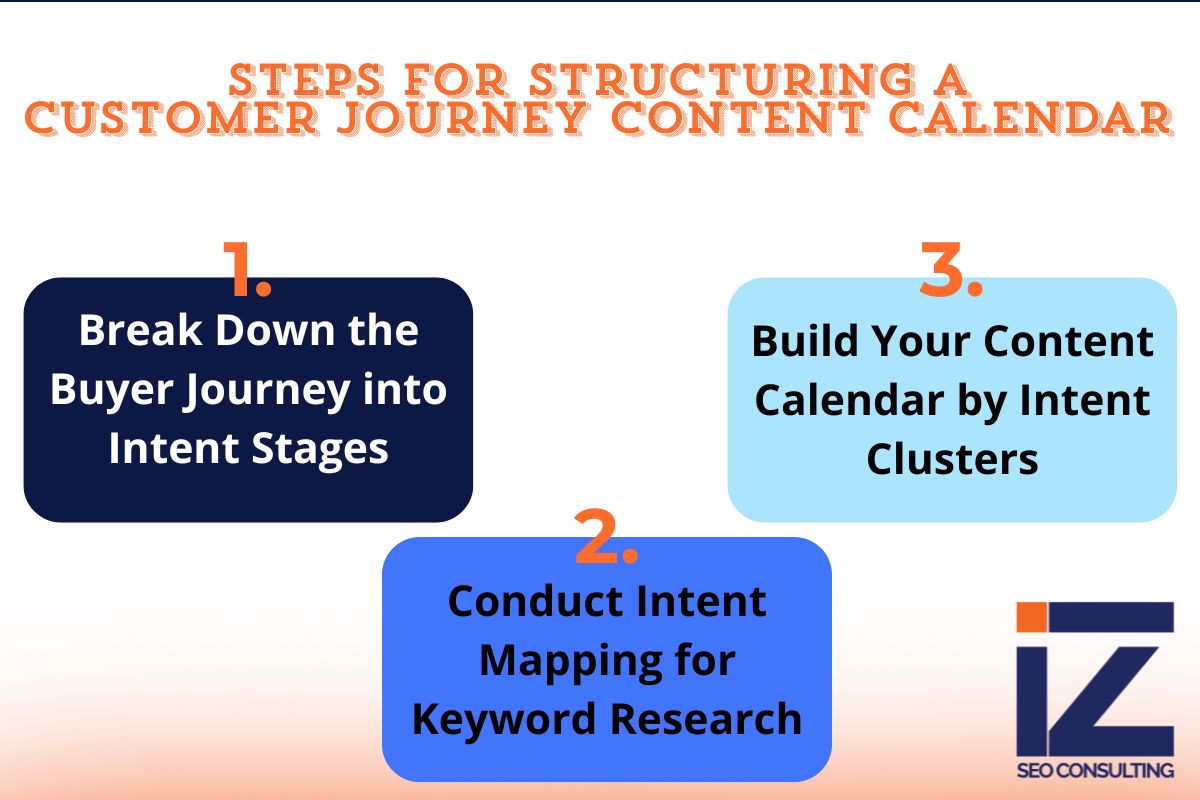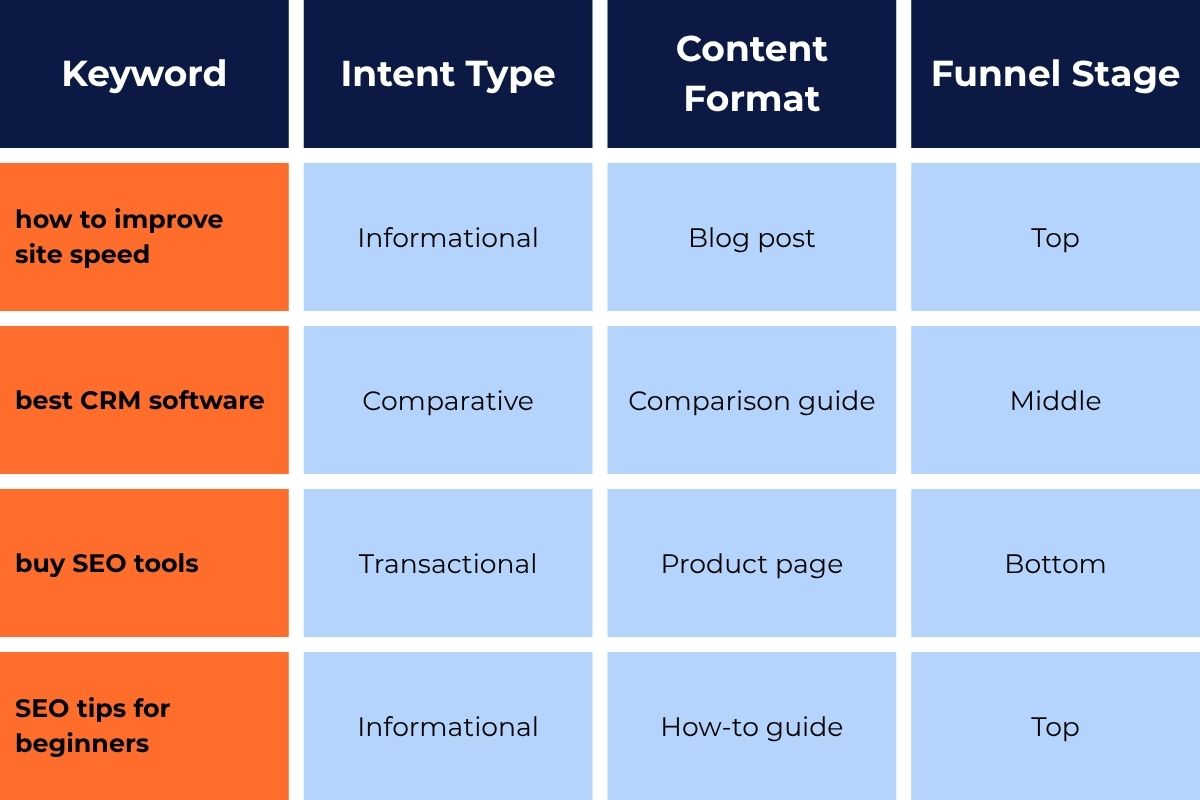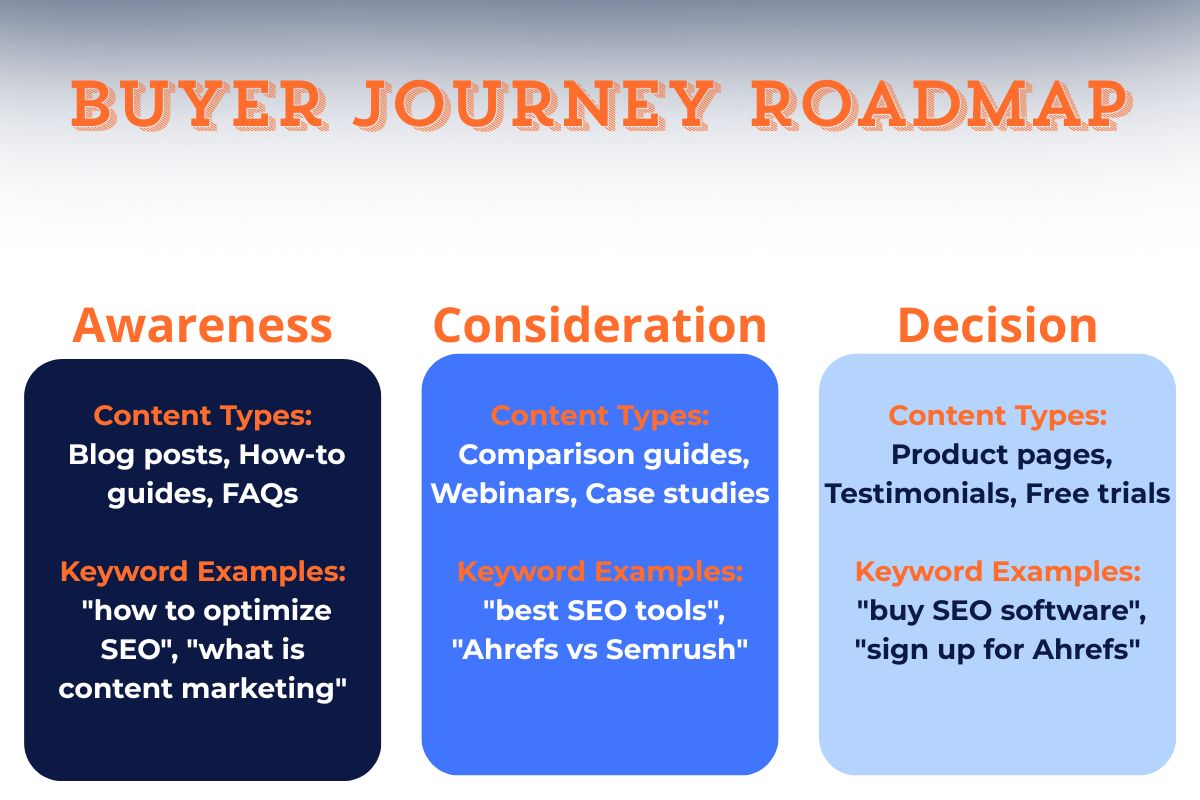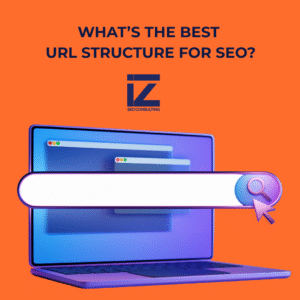Planning a customer journey content calendar has moved way past the days of throwing topics at the wall and hoping something ranks. The sharpest marketers today? They’re building calendars around one straightforward principle: customer intent mapping. This ties your content calendar SEO strategy to what people are genuinely searching for and when they exactly need it.
How to Map Customer Intent for SEO and Use It to Build a Content Calendar
A solid content strategy is about figuring out why someone’s typing that query in the first place. That’s where keyword intent mapping for SEO comes in and breaks down the “why” into clear phases of the buyer’s path. When you nail the intent early on, you can match content types, formats, and publishing schedules to meet people right where they are.
Here’s how to map intent and transform it into an organized content calendar:

Step 1: Break Down the Buyer Journey into Intent Stages
Every potential customer moves through three main intent phases:
- Informational – They’re exploring, asking questions, or trying to wrap their heads around a concept.
- Navigational/Comparative – They’re weighing options or looking closely at specific brands and solutions.
- Transactional – They’re ready to pull the trigger or commit to an action.
Match each phase with the right content type:
- Blog posts, how-to guides, and FAQs work for informational searches
- Comparison pieces, case studies, and webinars fit the middle stage
- Product pages, customer testimonials, and time-sensitive offers belong at the bottom
Step 2: Conduct Intent Mapping for Keyword Research
Grab your keyword list and start labeling each one by intent. Tools like Semrush, Ahrefs, or even Google’s SERP features can help you spot the signals:
- Are the top results blog posts, product pages, or something else entirely?
- Are searchers trying to learn something, compare options, or make a purchase?
This process, what pros call intent mapping for keyword research, keeps you from wasting time creating a buyer’s guide when people actually want to buy, or pushing a sales page when they’re still learning the basics.
🔍 Pro Tip: Sort your keywords by modifiers. Words like “how to,” “best,” “vs,” and “buy” instantly reveal what’s behind the search. Use these to group content ideas by where they fit in the funnel. For more on this, check out our SEO keyword research guide.

Step 3: Build Your Content Calendar by Intent Clusters
Now take those keywords, group them by intent stage, and plot them across your calendar. This is the core of intent-based content planning.
- Spread awareness-stage topics throughout the year to keep visibility steady
- Queue up middle-stage content to support your main product or service lines
- Align bottom-stage pieces with promotions, launches, or seasonal sales pushes
This is how to map customer intent for SEO in a way that doesn’t just fill slots. It actually guides people toward taking action.
What Is Intent Mapping in SEO?
What is intent mapping in SEO? It’s organizing your keywords and content around what the user actually wants, not just how many people search for it or how hard it is to rank. It ditches the old “stuff keywords everywhere” approach and replaces it with something that mirrors real search behavior. If you’re unfamiliar with terms like this, our SEO terminology page can help.
Why bother mapping intent?
- You’ll see better engagement and fewer people bouncing off your pages
- Content and conversion goals finally line up
- It becomes way easier to decide what to write next
Content Marketing by Search Intent: Real-World Examples
Here’s what content marketing by search intent actually looks like when you apply it:
Example 1: Software Company
- Top-funnel: “how to manage remote teams” → Educational blog post
- Mid-funnel: “best remote work software” → Comparison guide
- Bottom-funnel: “Buy [brand name] remote team software” → Product landing page
Example 2: DTC Skincare Brand
- Top-funnel: “causes of dry skin in winter” → Blog post with a subtle product mention
- Mid-funnel: “moisturizer for dry winter skin reviews” → Round-up of customer testimonials
- Bottom-funnel: “Buy [brand name] winter skincare set” → E-commerce product page
These search intent content strategy examples demonstrate how mapping keeps your content in sync with how real buyers think and move.
Common Pitfalls to Avoid
Even seasoned marketers stumble here sometimes. Keep an eye out for these mistakes:
- Guessing intent without checking – Always back it up with SERP analysis or keyword tools
- Ignoring the middle of the funnel – A lot of teams skip this and wonder why conversions stall
- Overloading one stage – Balance is key. Don’t flood your calendar with awareness content while ignoring transactional opportunities
Insider’s Edge: Intent Drift Monitoring
Here’s something most people miss: intent doesn’t stay frozen in time.
Google’s interpretation of a keyword can shift. A term that used to pull up blog posts might start showing shopping results instead. That’s why using search intent to build a content calendar isn’t something you do once and forget about.
Go back to your top pages every 6–12 months and reassess their intent. You’ll often spot chances to tweak or refresh based on how the SERP has changed. This is critical to keeping your content fresh with regular updates.
For more tips on creating high-performing content, explore our guide on how to create search-optimized content.
Using Search Intent to Build a Content Calendar That Actually Performs
When you get it right, building a content calendar this way means:
- Every piece has a clear purpose
- Each stage of the buyer journey gets attention
- Keywords and formats work together for maximum impact
Instead of a random assortment of blog posts, your calendar becomes a roadmap. One that mirrors the way people actually search and make decisions.

Final Thoughts: Start Structuring with Intent
Publishing content just to publish is a dead strategy. If you want real traction, you need to learn how to structure content calendar with buyer intent from the ground up. It begins with mapping search intent for content, aligning it with your customer journey content calendar, and staying committed to regular tune-ups.
A calendar built this way doesn’t just chase rankings. It converts traffic into leads, and leads into actual revenue.
At Indexed Zone SEO, we help businesses design content strategies that align with user intent and drive measurable results.
FAQ
It’s classifying keywords and topics based on what the searcher actually wants—whether that’s information, comparison, or a purchase.
It makes sure your content matches what users are looking for, which boosts engagement, clicks, and conversions.
Not at all. It works for videos, landing pages, product pages, social posts—you name it.
At least once or twice a year, especially for pages that get a lot of traffic or drive conversions. Intent can change as trends and algorithms evolve.



